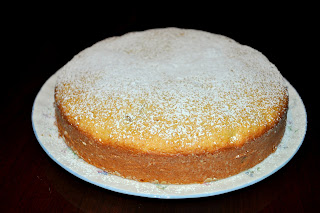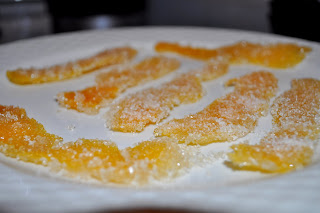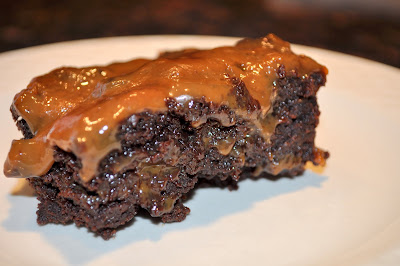
Given the hold that Tuscany has on the hearts of Americans, I’m surprised that we don’t drink more Vin Santo. It is even more surprising when you consider the hold that sugar has on the palates of Americans because Vin Santo is a dessert wine and typically sweet. But I guess if you’re downing Coca-cola at dinner, a dessert wine wouldn’t really end your meal on a special note.
Vin Santo translates to “holy wine.” Because it’s Italian, there are clearly numerous competing stories about how this golden liquid got its name. In fact if you ever visit Tuscany and you’re offered Vin Santo-as is apt to happen as a sign of hospitality- I’d encourage you to ask about its origins. The resulting tirade and doubtless arguing will last for at least twenty minutes, allowing you to continue to surreptitiously refill your glass. Besides, they'll love it. It’s what Italians play instead of Taboo.
Can't afford to go to Italy? Ok, here’s the run-down. One camp believes that in the fourteenth century a monk from Siena saved the wine leftover from mass and gave it to the sick, who called it Vin Santo. But if you’ve ever read The Canterbury Tales or any other work of medieval literature, you know that the monk was clearly drinking the leftovers himself or created a little wine trading business on the side.
Another group will argue that the name came about when John Bessarion, a patriarch of the Greek Orthodox Church, served this wine at a mass in Florence and his confused disciples thought that when he said Vin Xantho (Xantho means yellow in Greek) he said Vin Santo. I’d believe in that confusion (“What’d he say? Santo?” “Who knows! It’s all Greek to me!”) but it does seem more likely that the moniker "holy" was simply given to wines made during Easter Week, or even to any of the sweet wine which was used during the Mass.
Despite its ecclesiastical origins, Vin Santo is now made and drunk by laymen. (Often with biscotti for a nice post-dinner treat!) The wine is a D.O.C product which means that anyone who wants to make Vin Santo has to follow certain protocol. First, you have to use a blend of white grapes, specificially Trebbiano, Toscano, and Malvasia varietals. Vin Santo is usually a deep amber color, but occasionally you’ll find a red version made with Sangiovese grapes which is called Occhio di Pernice or Eye of the Patridge (you’ll have to do your own name-origin research on that one).
Once the Vin Santo grapes are harvested, they are allowed to dry out on straw mats in the sun until they get all sweet and shriveled. (Sigh. What I wouldn’t give to do that right now.) As a result, wet weather can ruin a vintage. Vin Santo also ferments in special small barrels, with a particular yeast, and needs at least three years to vinify. In other words, it’s a complicated process. And that’s how we get to the real reason that Americans may not be buying up huge quantities of this delicious drink: it’s expensive. A 375 ml bottle will set you back anywhere from $30 to $150. Oh well, it’s cheaper than a trip to Italy. Non?
Another boozy post? Yes, this is the third this month here at Less is Morbier. But the weather has been brutal, and one has to keep the spirits up. Plus did I mention I’m a little short of funds? I can’t let my unused alcohol go to waste, so I’ve found ways to cook with it. Or maybe I choose to cook with alcohol so that I can have some leftover to drink. It’s a bit of a chicken and egg situation, but who cares when the result is this delicious cake.
Let me also say: I don’t love super sweet wine, but a good Vin Santo has enough alcohol (16-18%) that it has a nice bite and an almond finish. The real trick is that Italians serve it with a less sweet snack, like traditional Tuscan biscotti. This pairing is what got me hooked on Vin Santo this summer, when I was living in San Francisco. The best part of my neighborhood (North Beach) was not the back-breaking hills but a small trattoria-pizzeria called Baonecci.
Baonecci is run by an Italian family who recently moved to SF from the outskirts of Lucca. The wife/mother is an ex-tattoo artist and absolute angel named Stefania who also happens to be a culinary genius. She makes thin crust pizzas with the most delicious, chewy yet crisp, slightly burnt and flavorful dough. My favorite kind was the MonteBianco: a pizza triumph made from Stefania's amazing crust and a homemade tomato sauce covered by ribbons of real prosciutto de parma, oozing fior di latte mozzarella- all topped by a big glob of mascarpone cheese that melts over the hot pizza just as you’re cutting your first slice. But I digress.
Baonecci was my favorite place to eat and I was there a lot. The whole family immediately took me and my boyfriend into their fold and they treated us like family for no other reason than the fact that they are awesome and we were so excited about their food. (It also probably helped that we’d get up at 7 am on Saturdays to watch the Italian World Cup games live with them). As a post-pizza treat, they’d sometimes offer us a small glass of Vin Santo and a plate of Stefania’s heavenly biscotti. I loved this. When you dunk the hard biscotti into the Vin Santo, it absorbs the wine and becomes soft. It's an almond-anise marriage made in heaven.
I made the following cake with some leftover Vin Santo. And though the words “leftover Vin Santo” might not occur much in your home, it is almost definitely worth the splurge. This cake tastes like Italy. It’s fluffy and moist from the Vin Santo and studded with Vin Santo soaked raisins. It’s got a haunting almond flavor from a triple hit of almond flour, almond extract, and almond paste. Italians call Vin Santo a vino da meditazione, or a wine to contemplate by. So take a slice, pour a glass, and meditate on how good it all tastes.
makes one 9 inch round cake
ingredients:
2 cups flour
3/4 cup Vin Santo
1/2 cup golden raisins
1/4 cup almond flour
2 tsp baking powder
1/2 tsp salt
1 stick unsalted butter, room temperature
3/4 cup sugar
3 ounces almond paste
2 large eggs
1/2 tsp vanilla
1/4 tsp almond extract
1/4 cup milk
confectioner's sugar for dusting
2 cups flour
3/4 cup Vin Santo
1/2 cup golden raisins
1/4 cup almond flour
2 tsp baking powder
1/2 tsp salt
1 stick unsalted butter, room temperature
3/4 cup sugar
3 ounces almond paste
2 large eggs
1/2 tsp vanilla
1/4 tsp almond extract
1/4 cup milk
confectioner's sugar for dusting
directions:
Preheat the oven to 325 degrees
Lightly butter a 9x2 inch cake pan and then dust with flour (try to shake out any excess).
In a small saucepan, combine the Vin Santo and the raisins. Bring to a simmer over medium heat. Take the pan off the heat and let the raisins plump up, about 10 minutes.

In a medium bowl mix together the flour, almond flour, baking powder, and salt. If you have an electric mixer, get it out, if not, a large bowl and a hand mixer will do. Beat together the butter and sugar until it's fluffy, about two minutes. Add in the almond paste and beat until the lumps are gone. Beat in the eggs and then the vanilla and the almond extract. While beating at a low speed, mix in one half of the dry ingredients. Add the milk, beat to incorporate, then beat in the rest of the flour mixture. Finally, beat in the Vin Santo and the raisins.

Pour the batter into your cake pan and bake for 35-40 minutes, or until the top is golden and a cake tester comes out clean.


Let the cake cool in the pan for 10 minutes and then turn it out onto a wire rack to finish cooling. Dust the top of the cake with confectioners sugar and serve with a small glass of Vin Santo.











































